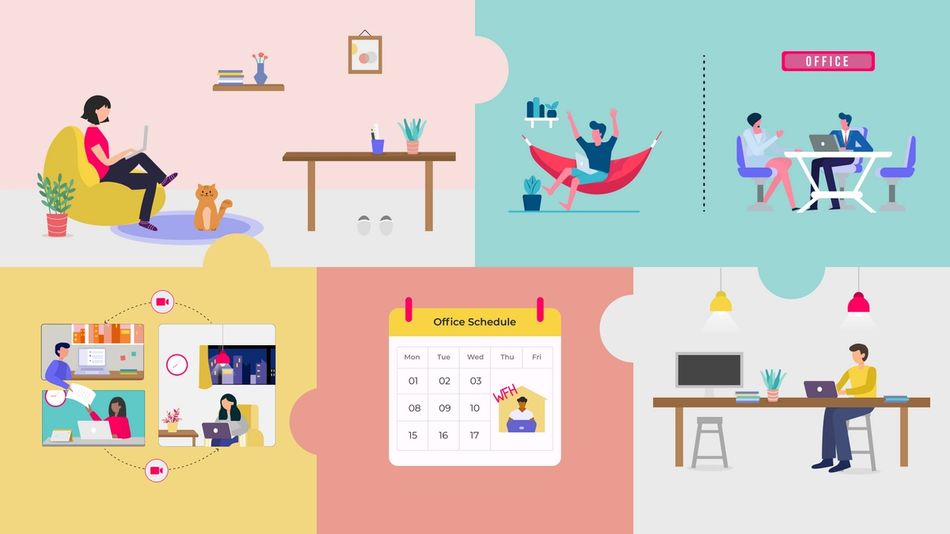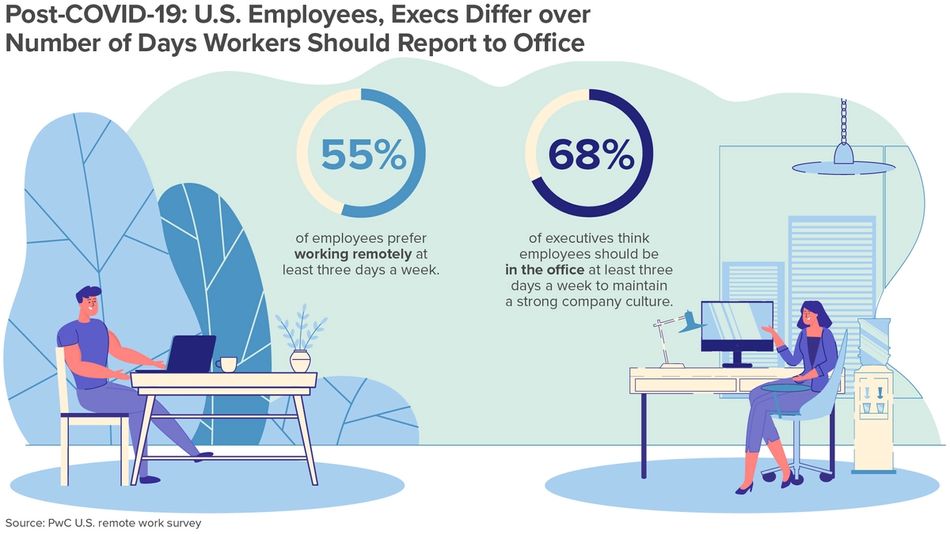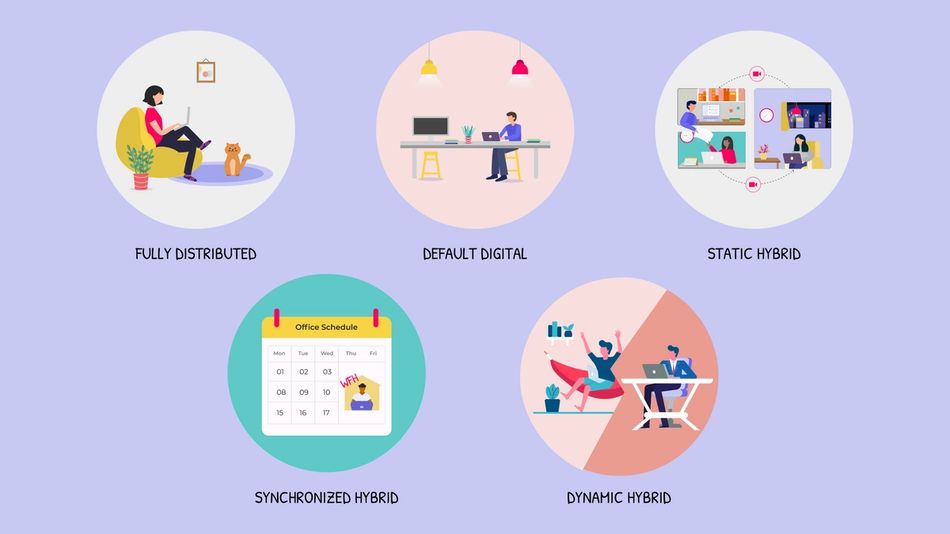
Introduction to hybrid team management
Simply put, a hybrid team is a structure where some teammates work from a central location, while others work remotely. On any given day, some employees may be in a headquarters or office, while others are dispersed in different locations, such as working from home, co-working spaces (e.g. a WeWork), coffee shops, or remote offices. In some hybrid variants each employee may change their location from day to day.
While hybrid working models have existed for decades, the COVID19 pandemic has radically changed the working world. Having been thrown into the deep end of remote work, thousands of organizations have determined that remote work works, and employees around the globe now want the option of not working in an office all the time.
For thousands of companies, the hybrid working model is no longer a “why” question, but a “how”. Hybrid work offers a number of benefits for organizations and employees, but it’s not without its challenges as well.
Let’s take a look at both, and examine how those challenges can be overcome as hybrid becomes the new normal for millions of knowledge workers.
How organizations, executives, employees are approaching hybrid work
The remote work genie is out of the bottle. In only a few months, the conventional wisdom that offices were critical to productivity, culture, and talent was upended on a huge scale. In a study released in June of 2020, McKinsey found 80% of remote workers said they enjoy working from home, 41% say that they are more productive than they had been before and 28% that they are as productive.
Fast forward to 2021; in a recent Mercer survey, approximately 83% of respondents said their companies are considering implementing flexible work at a greater scale than prior to COVID-19 pandemic.
However, as an indication of the challenges that come with this transition (more below), 66% of those same responded indicated that leaders' and managers' attitudes and skills toward managing a flexible workforce would be a concern moving forward. More than half said maintaining existing culture would be a challenge, while about 42% were concerned about inconsistent application of flexible remote work policies across their organizations.
Recent PwC research also showcased the gap between management and work. They found that 68 percent of executives believe employees should be in the office at least three days a week to maintain company culture, but over half (55 percent) of workers prefer to continue working remotely at least three days a week. And according to Envoy, 61% of office workers and more than half of young employees would consider looking for a new job if their employer didn’t offer hybrid work.

As people search for the hybrid team structures that will work for them, they’re realizing that no matter the model, each will require a significant adjustment and alignment in not just expectations between organizations, management and workers, but completely rethinking processes, interactions, work habits, and culture.
How new is hybrid work?
It's been common for some time for large companies to have multiple offices, and to allow some amount of telecommuting (the 2008 recession saw a big rise as companies worked to reduce operational costs). But collaborative, creative, and highly cross-functional work was usually the domain of co-located teams, being remote was usually only for senior people or people working on independent projects.
What has changed in recent years is that hybrid teams are now needing to be highly collaborative, and they need the right processes, tools, and spaces to do so. So while in the past some people might be in the office some days and work from elsewhere for others, cultures and tools and even office space were still tuned to a default co-located environment.
The realization that going back to the office does not mean going back to the same tools, processes, and culture we experienced in January 2020 is the seismic shift that’s forcing everyone to reassess how they are working.
Hybrid work models

At first, a hybrid work model seems straight forward — employees work from an office for some days, and elsewhere others. But there are actually many different models (and variations on these) that are meant to take into account different attributes of the organization, from business model, function and size to company culture and location.


Fully distributed team
Not a hybrid model, but a pure remote model pioneered by the likes of GitLab, Zapier, and Automattic. We should expect more companies to follow the path to becoming fully distributed, but it will still be a minority. Expect many startups to begin fully distributed, since it reduces costs and can make hiring easier, but as they grow they’ll often shift to hybrid models.
Being fully distributed requires intentionality in how you structure work processes. You have to actively design systems that facilitate information flow and cultivate belonging. However, because everyone is remote, there is a more of a level playing field, so in some ways it is the easier path.


Default digital
Many people can’t easily work from home; they might have kids or roommates, or no dedicated home office space. Some people simply like the separation of leaving the house, going to work, and being in an office with other people.
To make accommodations for these people, some companies will set up working spaces in urban hubs where there is a critical mass of employees. Sometimes this is called being a “remote-first team” or “virtual first.”
Being "default digital" means that there is no fixed expectations around where people are, and as such all work processes are designed around the assumption that teams won’t be in the same place at the same time. Take Dropbox as an example. Although they have office spaces in cities around the world, the company will provide guidance on specific use cases for those spaces. In a blog post, the company said, “Dropbox Studios will be specifically for collaboration and community-building, and employees will not be able to use them for solo work.”
Operationally the Default Digital model will be very similar to a fully distributed team. But it will take extra effort to ensure that those working in close proximity don’t fall back to informal conversations and in-person channels of communication, which often leave some people feeling excluded.


Static hybrid
A static hybrid team means you have a mix of office workers and remote employees, but locations are generally consistent. For example, you might work in an office in SF five days a week, while a colleague works from home in Colorado five days a week.
Project teams may be “defragged”, such that a team is all in the same office, while another team is fully distributed.
Consistency makes it easier to coordinate meetings and there are clear expectations about how different people interact. You and your Colorado colleague will always interact over video chat, you know there’s a timeshift, while another person on your team sits near you in SF, so you always have your 1:1s on the Embarcadero.
This model has predictability and operationally will be familiar to many people, as it was quite common prior to COVID. Companies like Google have always had teams split across several locations in a way that was functionally equivalent to this model.


Dynamic hybrid
We’re placing bets that this will be the most common model. On dynamic hybrid teams people will have reserved desk space at an office. However, teammates are able to fluidly move from working from home (or a coffee shop) to working in the office.
Some informal norms will exist, such as being in person for 1:1s or team meetings. And there may be guidance about how many days you can be in the office or working from home. But individuals will generally be free to do what they want.
This is how many “high trust” startups used to operate prior to COVID, but it’s not without tension. Different people have different expectations about presence, and managers in particular can find themselves frustrated about the lack of predictability.


Synchronized hybrid
As we saw above, with a small percentage of people wanting to return to the office full-time, management teams who favor in-person collaboration will be forced to make compromises in order to compete for talent.
A hybrid strategy where everyone is expected to be in the office on a synchronized schedule is more predictable for management and allows for traditional forms of collaboration and meetings to continue (picture sticky notes on the wall and project plans on communal whiteboards.) This will also lead to space redesigns to accommodate for more of this type of collaboration.
The most common form is likely to be a fixed weekly schedule. For example, “Friday From Home” or a Tuesday/Thursday split.
Challenges and benefits of hybrid work
Some challenges of remote work are obvious, while others might be tougher to spot.
- Where do leaders work?
While leadership may express their support for hybrid work, if they don’t emulate the model, it can break down. “Facetime” with leadership is a natural and major concern for workers, and if leaders are in the office the majority of the time, it will passively and actively influence how well any model works or doesn’t. - Meetings → One remote all remote
Meeting bloat has been a real problem for those new to remote. Many people look forward to a hybrid model helping them battle back the meeting and Zoom fatigue, but scheduling in the right way is a major challenge. If people are in the office on different days, then all meetings should optimize for remote. Do you need to mandate days where everyone is in the office during specific times for specific meetings? And inclusivity is a big issue in any meeting, but especially so in hybrid meetings, as remote workers can find it harder to participate. Read more about optimizing your standup meeting for hybrid work. - Time Zones and coordination
Accommodating time zones and coordinating not just hybrid meetings but team communication is complex in any workplace model, but especially so in hybrid. Keeping teams in-sync can lead to more meeting bloat and a deluge of Slack messages and email, all of which eats into focus time. Without the right hybrid model tool stack (see below), out-of-sight, out-of-mind can take hold, and remote teammates can start to feel unengaged and alienated. - Performance management and feedback
A hybrid model can perpetuate different employee experiences, with potential negative impacts to career trajectories and professional development. According to Gartner, 64% of managers are more likely to give office-based workers a higher raise than remote workers as they see them as higher performers. However, the data shows full-time remote employees are 5% more likely to be high performers. - Culture building
A hybrid work environment can also perpetuate different experiences of workplace culture for employees. Unless organizations and managers are intentional about tools and activities that can connect teams everyday, activities that leave out remote workers can quickly create a sense of second class citizens among teammates. Watch our webinar on supporting culture in a remote-first work environment.
Benefits
- Increased flexibility
The most cited benefit, flexibility is top of mind for employees and top of mind for organizations wanting to attract and retain them. Establishing a work environment and practices that allow teams to work in ways best suited to their circumstances so teams can consistently be highly effective is no small undertaking, but organizations that invest in the tools and develop flexible models will reap the rewards. - Increased engagement
Teams that develop the practices that facilitate connecting every day, such as answering an icebreaker question, game sessions, or sharing their mood (activities we use at Range), whether they are remote or in the office, see increased levels of engagement, psychological safety and trust, and in turn, stronger cultures. - Increased productivity
Teams that can optimize where and how they work can realize significant improvements in productivity. They can adjust their schedules to focus on the right work in the right way, and have a better sense of what environment is right for what work. - Resilience becomes the modus operandi
Disruptive change is increasingly the norm, and developing the capabilities to navigate change and adapt to new circumstances is a hallmark of highly effective teams. The processes that make remote work work can also help teams build their “resilience muscles” as does the ability to shift between different work environments.
Consider your hybrid work stack
At Range, we’ve worked with multinational companies, remote-first companies, startups, tech giants, nonprofits, and more. Effective remote companies invest across all the following areas, and these should be core components of any hybrid work plan:

Is hybrid right for you?
While there are challenges, the future of work will be hybrid. When done right, it combines the advantages of distributed teammates for hiring and flexible schedules with the culture and collaboration benefits of offices. Win win.
Employees will come to expect a flexible work arrangement and companies who can support both office-based and remote staff will better be able to attract top talent, be more resilient, develop highly effective teams and, in turn, make success the norm, not the exception.
At Range, we’ve built tools that support flexible schedules and foster team identity, even when remote. With asynchronous check-ins and synchronous team meetings, Range is the best way to stay connected and get the information you need to do your job.




